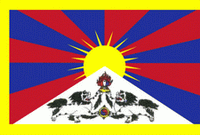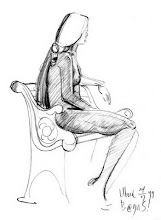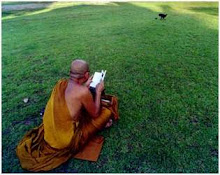Tubagus P. Svarajati, CONTRIBUTOR, SEMARANG, CENTRAL JAVA Sun, 01/18/2009 1:27 PM Arts & Design
They were oversized steel-plated typewriters. Strangely, the dark yellow machines had no type levers. Their casings were turned into pick-up open containers with different loads – the one packed with dozens of giant matches, the other with chunks of river stone.
The huge typewriters (180 x 120 x 50 cm) were entitled “Sang Pewarta #6” (The Reporter #6) and “Sang Pewarta #7”. Both were made of steel plates and fiberglass, covered with spray paint and mahogany.
These were the creations of Saftari, 38, a graduate of the Indonesian Arts Institute (ISI), Yogyakarta. He was holding a solo exhibition themed “Anxious Objects” at the Semarang Gallery, held from January 1-15. The display’s curator was Rifky Effendy.
Apart from the two objects, Saftari presented two other installations and 13 acrylic paintings on canvas. All of them were his 2008 works.
Quoting the artist, the curator said the theme of the paintings was not intended to give profound meanings to their objects. Nor were they meant to express any apprehension or fear of the dangerous consequences of environmental damage.
In the curator’s view, Saftari presented the ironies of life and individuals. The images he composed were captivating, reflective and sublime.
Indeed, Saftari’s pieces in general offered an enchanting sight. He worked on his paintings meticulously, neatly and cleanly, making them pleasant to scrutinize. His canvases come in large sizes, over 150 x 150 cm.
Matches became his main subject. The fire sticks were portrayed in their veined, neatly (even too neatly) cut and stacked form. Their dimension of depth was fairly well illustrated by the technique of chiaroscuro (light and shade treatment). Their carbon-knob tips were seemingly ready to strike for fire.
Shapes and colors constituted the major elements of his paintings. The sensations that emerged came from, among others, the repetitive rhythms of the sticks. This aspect could actually help observers become engrossed in the creations.
Most of Saftari’s canvases showed single and delicate nuances with an emphasis on pastel color tones. In “Sensitive #2” (200 x 300 cm) and “Sensitive #3” (200 x 200 cm), the shades were very poetic, with pink and orange dominating the knob tips of the sticks.
The only picture decorated with texts was “Explosive #2” (180 x 180 cm). The main feature was a bunch of matches with a burning fuse – right in the middle of the blood-red canvas packed with the words “fire”. An overwhelming message, isn’t it?
An easy message was suggested by panoramic “Explosive #3” (100 x 370 cm). The canvas was laden with a pile of matches on the left. Amid the sticks was a gunungan (a Javanese leather-puppet mountain). A fuse ran across the stack, burning on the right. Is it a symbol of the imminent extinction of Javanese culture?
It’s anyone’s guess why the paintings with the same subject —match sticks— carried different titles in the “Sensitive” and “Explosive” series, distinguished only by the presence and absence of a fuse.
In addition, three pictures had no clear meanings. Each of them (Pewarta #3, #4, #5”) presented a typewriter and a wooden chair. The machine was flying, perching on a group of twigs, or lying on a rock. The three were just apparently iconic representations of a nature showcase.
His installation works boasted some freshness, however. Along with the two mentioned earlier, two others were “Business of Java” (235 x 22 x 19 cm, manual counting machines, of fiberglass and teak wood) and “Menu Hari Ini #2” (Today’s Menu, 70 x 57 x 40 cm, a typewriter, of iron plates, stainless steel, rugos lettering and fiberglass).
“Business of Java” comprised two old manual counting machines with operating levers on their ends. Both devices were connected with a long wooden plank.
“Menu Hari Ini #2” was a large typewriter with its top inner side containing two gas stove burners. Above the machine’s top casing was the grating cover of an electric fan.
Despite the obscurity of their interpretations, the two installations generated an enigmatic impression. They were something fresh.
The shapes and substances of Saftari’s creations are not always parallel. Frequently their formal manifestations are stronger than their essence. This has become a general phenomenon in Indonesia’s contemporary fine art practice.
Yet most painters produce their works with simple visual portrayal, by manipulating external factors instead of going deeper into paradigmatic ideas. Consequently, almost no transcendental values are emanated.
In the case of Saftari, the values he was supposed to put forward perhaps involved the “ironies of life”. He seemed to criticize the excessive utilization of wood. This fact has led to the arbitrary practice of tropical forest destruction.
If forests are stripped bare, the environment is under threat, with its growing, imminent dangers. This could be the way he reasoned.
Environmental devastation should of course be prevented. Nonetheless, can the message get across if merely conveyed in a “beautiful” (read: Captivating) manner? Are the “beautiful” images capable of inducing some reflection, which is sublime (in the curator’s word)?
Fine arts relying only on simple visual illustrations are not strong enough to perpetuate the substance to be assigned to them. In Saftari’s paintings, this essence lies behind the veil of his enchanting visual depictions.
The writer is a fine art critic, living in Semarang
Anxious Objects
A solo exhibition
Semarang Gallery
Jl Taman Srigunting 5-6,
Semarang, Central Java
[Source: http://www.thejakartapost.com/news/2009/01/18/a-tale-humble-matches.html]



















No comments:
Post a Comment